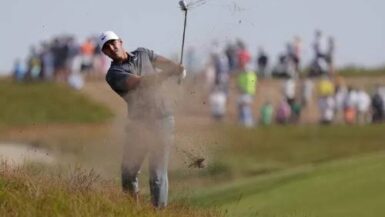—Friends to Jay: “Who’s going to win the U.S. Open this year?”
Jay to Friends: “Oakmont, that’s who.”—
Of all the major championship venues I’ve seen in my career as a sports writer – and I’ve see everything from Augusta to Pebble and back – Oakmont is my favorite. Cresting the hill of the second fairway, when the great grassy ski slope unfolds before you in all its majestic grandeur, you’ve truly been transported 100 years in the past.
Oakmont has everything you can possibly ask for in golf course design. The fairways are canted to one side or the other, so uneven lies are prevalent. The curvaceous greens are rivaled perhaps only by National Golf Links of America and Augusta National in terms of their fiendishly clever intricacy and wild undulation. And the fast and firm conditions – perhaps we should say fastest and firmest – make it imperative players consider what’s going to happen to the ball after it lands and factor that into their shot planning.
Then, of course, they have to hit the shot, and the margins are razor thin at Oakmont.
As poet Omar Khayyam wrote in his famous Rubaiyat, “A hair divides the false from true,” and that is the difference between a birdie opportunity and a certain bogey or worse. If the U.S. Open is a final examination in golf, then Oakmont is the doctoral dissertation. Perhaps nowhere besides Pinehurst makes you dissect each shot with surgical precision.
“It has all the charm of an S.S. Commandant the way it is set up for a tournament,” quipped quintessential golf architect Tom Doak in his indispensable tome The Confidential Guide to Golf Courses. “But the more they whined about it the more I grew to appreciate it. It kept the best players in check without resorting to the water and out of bounds that modern designers use too often.”
“It’s the hardest course I’ve ever seen,” said veteran looper Bones McKay, who’s been on the bag for all five of Phil Mickelson’s major championship victories…and McKay’s boss said exactly the same thin just yesterday.
Indeed, Oakmont was designed to be that way – the hardest golf course in the world, a poor shot penalized, a stroke irretrievably lost – and Henry Fownes, the architect credited with the design, would take all of those comments as compliments. Fownes fulfilled his mission: Oakmont is certainly on the short list of “Absolutely the Hardest Course in the World,” along with Winged Foot, Carnoustie, and Oakland Hills. The wildest green complexes, he longest rough, the massive rumbling, tilted fairways, and the deepest bunkers: since its opening in 1903, this slavering jawed, bloody-fanged Oakmonster has hosted nine U.S. Opens, three PGA Championships, five U.S. Amateurs, and two Women’s Opens.
“I’ve certainly not seen a golf course around this country that is more focused on championships than Oakmont Country Club,” said USGA Executive Director Mike Davis. “It’s often said that the USGA could host an Open literally on a moment’s notice and while I’m not sure that’s exactly correct with all the grand stands and tents that you see outside, I really do believe this is the one golf course in the United States that, if we had to make a call one to two weeks before the U.S. Open and say, we’re in a pinch, can you host the national Open Championship, this place could do it.”
There you have it everybody! The USGA Executive Director just confirmed it: Oakmont is their Go-to Guy!
Part of the reason is that Oakmont members are masochistic…in a good way. They like playing their course under U.S. Open conditions on a daily basis. There were some Opens – 1973 is the most glaring example – where certain members groused, “We play a harder course than they saw this week!”
And that’s the reason why Johnny Miller’s 63 – historic and phenomenal though it was – Miller’s 63 needs an asterisk by it. It wasn’t Oakmont that hosted the 1973 U.S. Open, it was Soakmont. And the difference is the lightning but vs. the lightning.
In 1973, between seven and nine inches of rain fell during tournament week, including a drenching the night before the final round, and that was on top of a 100-year downpour the region endured that spring. Oakmont is built on clay, not sand, and in 1973 no one even dreamed about sub-air systems, misters, or any of the other modern techniques we can employ now.
So on Father’s Day in 1973, Johnny Miller wasn’t playing golf; he was playing lawn darts.
No before you start sharpening the long knives, stop and think about this statistic: that week there were also two 65s, two 66s, a fistful of 67s and 68s, and a total of 29 rounds in the 60s that week. Like I said: Soakmont.
Don’t believe me? Well how about the 1978 PGA Championship, also decimated by storms out of the pages off the Last Judgment? John Mahaffey finished 68-66 and Jerry Pate went 66-68 to catch Tom Watson and force a playoff Mahaffey won. Like 1973, the rain slowed the greens to a reasonable speed, and shots did not stray far off the greens or fairways.
Additionally, remember: Oakmont is comparatively short. This year, the course will play between 7159-7257 yards (the tee location changes day to day on several holes, including the par-3 8th and par-5 12th. In fact, Oakmont has never been about length. After his 69 in 1994, when asked how he did it, Nicklaus said “it’s not a long course.”
“It’s not about length here,” said the member who spoke earlier. “This is not a long course by today’s standards. But we want to see the pros play Oakmont under the conditions we play it. Our members are playing to harder pin positions every day than they did in that [1973] Open.”
To illustrate, this year, there are three drivable par-4s, two, ten, and 17 and a total of five par-4s under 400 yard. The maximum yardage the course will play is 7,219 yards, virtually identical to the 2007 Oakmont. Once again, it will play a par-70. 210 bunkers will be in play, down from 300 once.
“These are the same fairway widths and contours the members here at Oakmont have been playing for years and years. They’re the same grass heights from 2007. The same green speeds as 2007. The same general hole locations as 2007. Same bunkering and the same wonderful course conditioning that John Zimmers and his staff have done, praised Davis. “So the point here, ladies and gentlemen, is we can come to town and essentially take Oakmont as is.”
That’s Oakmont: U.S. Open conditions 24/7, 365. Author Curt Sampson wrote about Oakmont, “monumental and forbidding, it’s the Mount Everest of golf courses,” but that might be being to kind to Everest! Of all the great mountains of the world, Everest is, comparatively, an easy climb.
“Nowadays, the sherpas can carry you to the summit of Everest,” said one expert climber I know, who is also a golfer. “K2 or Nanga Parbat, on the other hand, are for expert climbers only, they’ve killed people by the dozens. So has Oakmont, actually, metaphorically of course.”
Oh, has it ever! Perhaps only Winged Foot has as grim and populated a graveyard of champions as Oakmont. Take, for example, Sam Snead, Arnold Palmer, Tom Watson, and Tiger Woods, all of them immortals. Between them they have 35 major championships and four Oakmont heartbreaks.
“Any shot can turn into a catastrophe,” Palmer reflecting upon his 1962 U.S. Open playoff loss to Jack Nicklaus. “It’s a tough course to avoid a disaster.”
“You can have a 10 foot putt that breaks eight feet or you can have a 20 foot putt that breaks three ways before you get to the hole, but you’re not going to have too many that are just right edge firm,” observed Tiger Woods after Angel Cabrera nipped him at the post for the 2007 U.S. Open. After that loss, Tiger also said he didn’t think a 10 handicapper could break 100, triggering three futile made-for-TV snooze-fests following Joe and Jane Sixpack flailing away like they were scything wheat. The girl – actually a six handicap and selected to promote the whole “Battle of the Sexes” agenda
So how do you beat Oakmonster, or at least get the better of it more than everyone else?
1. Be the head professional at a nearby club with reciprocal privileges at Oakmont. That’s how 25-year old club pro Sam Parks, Jr. did it. He played Oakmont every day for a month shortly before the tournament;
2. You can close the tournament 3-3-3, like Ben Hogan did in 1953 to speed away from Sam Snead with a finishing kick that made the Slammer look like he was standing still. The 250 yard par-3 16th is one of the most fearsome holes in golf, especially with a U.S. Open in thee balance. The short, tempting, yet impudently tricky par-4 17th can deal out anything from an eagle to a triple bogey. And 18 is 484 yards of sheer murder;
(By the way, back then Hogan, who had won three of the last five U.S. Opens, still had to go through 36 holes of qualifying. Talk about running a credit check on Warren Buffet!).
Hogan’s scintillating finish also prompted one disgruntled opponent to angrily roar, “How do you shoot 67? Hit every goddamn fairway and every goddamn green to 10 feet, like Hogan did;”
3. You can open the tournament 3-3-3, like Jack Nicklaus did in 1962. Okay, so he didn’t lead wire-to-wire. In fact, he had to come from behind to tie Arnold Palmer on Sumday before speeding away from him again in the playoff. But the triplets he opened with on Thursday set the tone for the week.
“I had won six tournaments that year, including the Masters, but it was obvious Jack’s moment had arrived, and I told everybody that despite having home field advantage, watch out for Jack. He had the look of a champion and his ability to focus was unparalleled,” recalled Palmer in a memoir.
“It started to materialize right at the opening bell. Paired together with Jack for the first round, with 12,000 people lining the first fairway, Jack started with three 3s, all birdies. “After 3 holes, I was behind by five strokes,” he stated.
4. None of those work for you? Didn’t think so…that’s a short list of All-time immortals there. Okay, try this: Greens in Regulation. Since the introduction of the Mike Davis’s graded rough, driving accuracy has lessened in importance, while greens in regulation and putting have stayed the same or increased in importance. This is despite Oakmont having one of the highest Cost of Rough Indexes in golf – a whopping .47 strokes.
Next, avoid the fairway bunkers at all costs. According to Head Superintendent John Zimmers, they are the most penal in the world.
“You aren’t going to advance the ball more than 150 yards if you get in one. That’s why we shaved the rough in front of the bunkers, so the players get in them more often,” Zimmers explained. That’s actually the major only change you’ll see this year at Oakmont. It will be interesting to see how the stats compare between 2007 and this year.
So who’s going to win? Rory McIlroy has the most complete game. He’s our favorite. Jason Day will be right behind him, ready to pounce if Rory makes a mistake down the stretch. Adam Scott has the complete game and power to contend, and Sergio Garcia has been rounding into form nicely this year. You need too much power at Oakmont if you get in the rough. Jordan Spieth is not Angel Cabrera, who has ten more steaks and eight crème brulees packed around his haunches to catapult the ball out of the fearsome Oakmont rough. Finally, watch out for Smylie Kaufman for a sleeper pick.
Other top contenders include Bubba Watson, Rickie Fowler, and Louis Oosthuizen, who has holed out three times from the fairway on Championship Sunday of a Major and not won any of those three, even though he was deep into contention. He did vaporize everyone at St. Andrews, and he plays his best on the biggest stages.
So that’s Oakmonster – a perfect 10 of a golf course, a beautiful firebreather, and it does it without a lake, an ocean, a waterfall, a canyon, or anything other than rumbling terrain, gargantuan green contours, and the creative eye of Henry Fownes.
“Most of the holes – 16 out of 18 perhaps – are straight away. What Fownes did was really lay the golf course on those hills, used the topography as he found it,” extolled Davis. Bt then again, that’s what all the greats did, and that the first duty of an architect. Find the property’s natural charm, and then fearlessly design right into the teeth of it. And that’s exactly how the golfers will have to play it if they want to hoist the championship trophy – play into the fearsome teeth of the Oakmonster.






